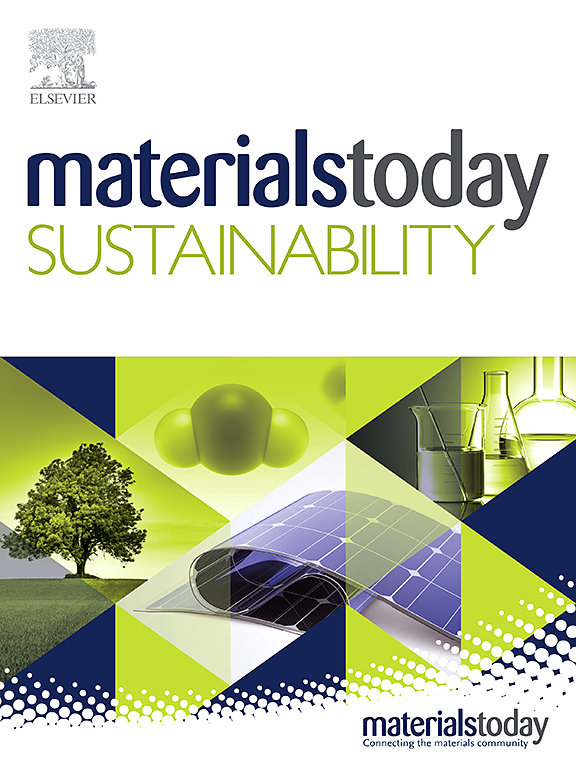Enhancing high ionic conductivity of polyacryamide/hemp cellulose nanofibers for utilizing as quasi solid electrolyte composites in flexible rechargeable zinc-ion battery with high-safety
IF 7.1
3区 材料科学
Q1 GREEN & SUSTAINABLE SCIENCE & TECHNOLOGY
引用次数: 0
Abstract
Rechargeable zinc-ion batteries (ZIBs) have attracted broad interest in the large-scale energy storage industry as well as wearable and portable electronics. This work presents safe quasi-solid-state zinc-ion batteries (QZIBs), highlighting the use of polyacrylamides (PAM)/hemp-derived cellulose nanofibers (CNFs) as quasi-solid electrolyte (QSE) composites with cobalt manganese carbon nanofibers (CMO-CNFs) cathode composites. Results demonstrate that CNFs with different concentrations (0.25, 0.50, 0.75, and 1.0 wt%), in addition to PAM, show superior electrolyte uptake and high ion conductivity. For plating/stripping testing with a symmetrical zinc cell, PAM/CNFs 1.0 wt% (PNC1) are seen to display the lowest overpotential with the best zinc dendrite suppression feature. For the QZIB performance test, innovatively constructed Zn//PNC1//CMO-CNFs achieve remarkable electrochemical performance. A high discharge specific capacity of 207.84 mA g−1 at a current density of 0.05 A g−1, as well as during cyclic stability, outstanding 59% capacity retention after 500 cycles is obtained. Furthermore, QZIB exhibits promising prospects, demonstrating robust stability after various mechanical stresses. Moreover, PNC1 maintains seamless operation even at sub-zero temperatures, enhancing its applicability across diverse environmental conditions.
提高聚丙烯酰胺/大麻纤维素纳米纤维的高离子导电性,用于高安全性柔性可充电锌离子电池的准固体电解质复合材料
可充电锌离子电池(zib)在大规模能源存储行业以及可穿戴和便携式电子产品中引起了广泛的兴趣。本研究提出了安全的准固态锌离子电池(QZIBs),重点介绍了聚丙烯酰胺(PAM)/大麻衍生纤维素纳米纤维(CNFs)作为准固体电解质(QSE)复合材料与钴锰纳米纤维(CMO-CNFs)阴极复合材料的使用。结果表明,除了PAM外,不同浓度(0.25、0.50、0.75和1.0 wt%)的CNFs还表现出优异的电解质吸收和高离子导电性。在对称锌电池的镀/剥离测试中,PAM/CNFs 1.0 wt% (PNC1)显示出最低的过电位和最佳的锌枝晶抑制特性。在QZIB性能测试中,创新构建的Zn//PNC1// cmos - cnfs取得了显著的电化学性能。在0.05 A g−1的电流密度下,放电比容量高达207.84 mA g−1,并且在循环稳定性中,500次循环后的容量保持率高达59%。此外,QZIB在各种机械应力下表现出良好的稳定性,具有广阔的应用前景。此外,PNC1即使在零下温度下也能保持无缝运行,增强了其在各种环境条件下的适用性。
本文章由计算机程序翻译,如有差异,请以英文原文为准。
求助全文
约1分钟内获得全文
求助全文
来源期刊

Materials Today Sustainability
Multiple-
CiteScore
5.80
自引率
6.40%
发文量
174
审稿时长
32 days
期刊介绍:
Materials Today Sustainability is a multi-disciplinary journal covering all aspects of sustainability through materials science.
With a rapidly increasing population with growing demands, materials science has emerged as a critical discipline toward protecting of the environment and ensuring the long term survival of future generations.
 求助内容:
求助内容: 应助结果提醒方式:
应助结果提醒方式:


